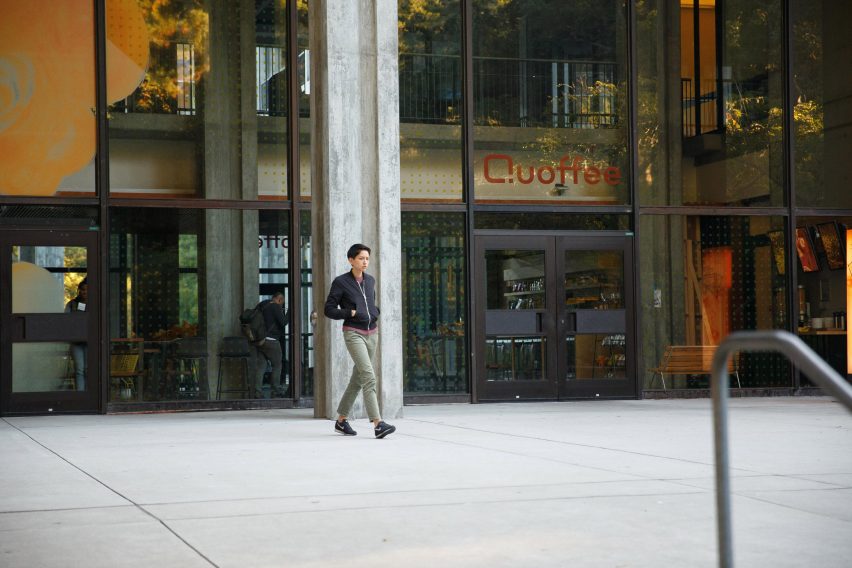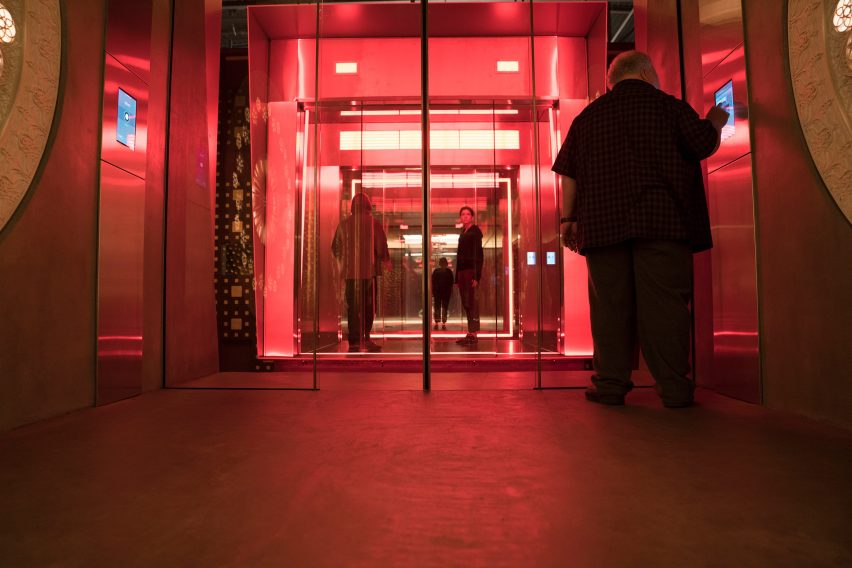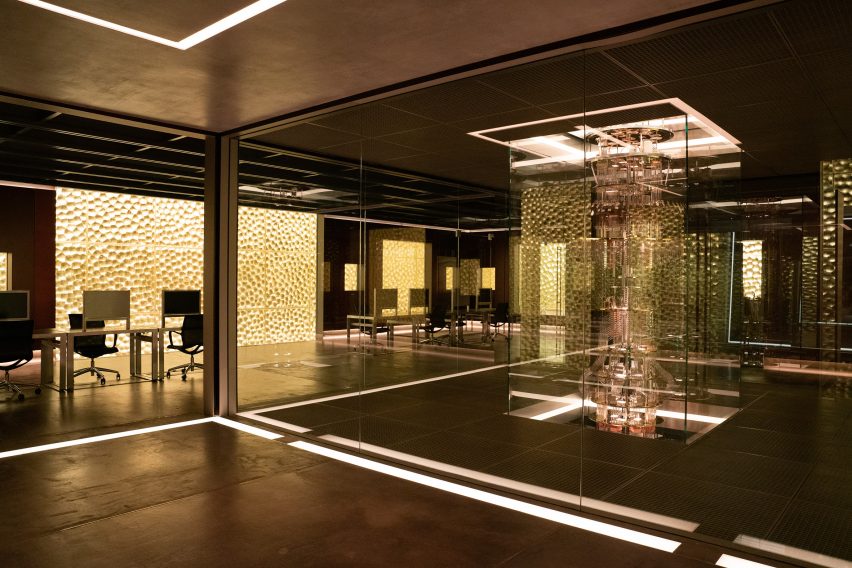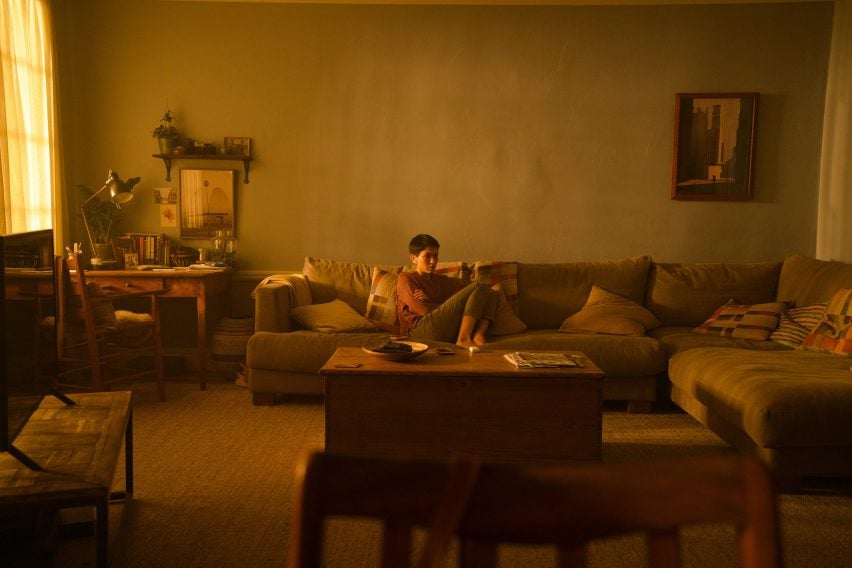Production designer Mark Digby explains why he selected an inconspicuous 1960s university library as the location for sci-fi series Devs, which was created by Ex Machina and 28 Days Later writer Alex Garland, instead of ultra-futuristic buildings in Silicon Valley like the Apple Park.
Devs explores the sinister goings-on at a fictional quantum computing company called Amaya, so finding the right building was essential to fostering the dark mood of the show.
Digby initially looked to replicate the feel of technological corporations like Facebook, Apple and Google, but he decided that this wasn’t quite right.
“We imagined that it might be something as futuristic, modernistic and as new as that,” said Digby, who also worked as a production designer with Garland on Ex Machina and Annihilation.
“But then two things came along – one is that it’s very hard to get access to those buildings for filming, the other is that they are very well known and recognised,” he told Dezeen.
“So we started thinking around that, and therefore you go to look for buildings that are one level less exclusive – and actually some of the most interesting.”

Devs is largely set in the McHenry Library in Santa Cruz. Photo: Raymond Liu/FX
From the outset of the eight-episode series, which was also directed by Alex Garland, its made clear that Amaya is a hugely successful company – however, what exactly goes on in its Devs labs is kept suspiciously vague.
Protagonist Lily and her boyfriend Sergei, who both work at Amaya, soon run into trouble with the CEO.
University library was “perfect” setting for technology company
Digby set out on a global hunt to find a location that matched the “stylish, imposing and overbearing” mood of Amaya.
First, buildings in the UK were considered – like the McLaren Technology Centre designed by Foster + Partners – before a wider search was carried out in the US.
Eventually, it was decided that the Amaya offices would be set inside The McHenry Library on the campus of University of California, Santa Cruz.
Designed by American architect John Carl Warnecke in 1968, the building features towering concrete columns and a gridded facade made up of expansive panels of glass. It’s burrowed amongst a grove of towering redwood trees.
“The minute we stepped in there it was perfect,” said Digby, “it was stunningly beautiful in its landscape, its building and its variety.”
“Museums and campuses are often at the forefront of their time of interesting architecture.”
“We all loved the idea of a tech headquarters that seamlessly embedded itself into the surrounding nature, each element informing the other,” added cinematographer Rob Hardy.

Characters use a lift to access the Devs offices, which are set inside a floating lead cube. Photo: Miya Mizuno/FX
The interior of the Amaya office features glass-walled meeting pods and clusters of casual seating for employees – it’s meant to offer a “less flamboyant” take on the workspaces seen around Silicon Valley.
“They were the people that brought along, or we imagined brought along, a breaking down of all the traditional barriers in workplace environments – how you have coffee, how you play, how you dress,” explained Digby, “you have to look at that legacy.”
“We particularly wanted to look at where [offices] might have moved one step further – because [the show] is not in the far future, it’s embedded in now,” he added.
Devs building is “magic on the inside”
Character Sergei’s problems begin in the first episode of the series when he’s recruited to join Amaya’s secretive Devs department. The Devs building is a monolithic concrete block set away from the main company offices in a woodland clearing.
“It was driven by simplicity – it’s supposed to be somewhat secret, low-key and not recognisable,” said Digby.
“Really, it is supposed to be a block that you don’t really spend too much time looking at. The inspiration, beauty and magic are on the inside.”

Interiors of the Devs office are lined with gold to protect the central quantum computer.Photo: Miya Mizuno/FX
The interior of the building is a huge empty space. At its centre floats a lead cube that accommodates employee workspaces, the surfaces of which are lined with gold. All of these elements are meant to shield Devs’ central quantum computer from outside interference.
Digby says that it was initially “daunting” trying to envision such a technologically advanced environment, but the design came together after months of research – vacuum chambers used by NASA and computer circuit boards were key points of reference.
“There are these really beautiful gold pieces within electrical components, so although we don’t imagine gold as being part of the tech world, it very much is,” added Digby.
To create the gold walls of the Devs building it required the hands of six members of the design team, who had to line the entirety of a 27-by-12-metre studio set in gold-leaf tiles.
Homes in the show each had a “distinctive personality”
Careful attention was also paid to the domestic spaces that feature in the series. The unassuming suburban property that Amaya’s CEO resides, for example, takes inspiration from the humble first houses of industry giants like Facebook founder Mark Zuckerberg.
Lily’s apartment is meant to have a similar feel to those in San Franciscan neighbourhoods like Dolores Park where Digby says “new techies” often flock to live.

Lighting is used to fuel a sense of drama in character Lily’s apartment. Photo: Miya Mizuno/FX
Other than a couple of artworks and a cluttered writing desk, there are very few decorative props in Lily’s home – cinematographer Rob Hardy instead relied on lighting to set the tone of different scenes.
“The domestic spaces each had a distinctive personality, not only in relation to their geographical position in the city but also the shifting psyche of their inhabitants. So much happens in Lily’s apartment, narratively and emotionally, and it was important to keep the visual clock turning,” Hardy explained.
“Using large tungsten sources, I would often mix cooler and warmer light, this colour mix created what I would call a ‘light pollution’ that resulted in a soft, rich and sometimes dense mood within the space.”
“We decided that we wanted a progression of environments,” added Mark Digby.
“We wanted to move from the more normal and regular, which were people’s family houses, to the Amaya campus which is a little more special. Then we had to blow everyone out of the water with the Devs cube.”
Devs is available on BBC iPlayer in the UK. All images courtesy of FX Network.
Source: Rooms - dezeen.com


